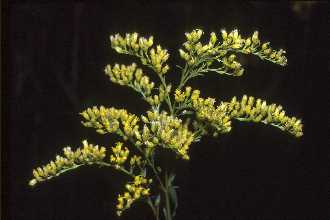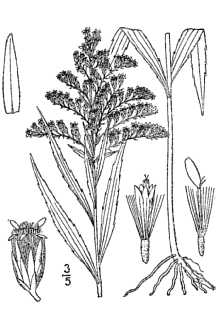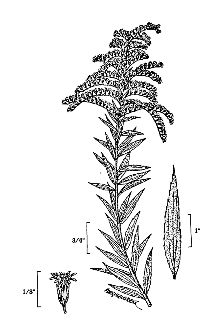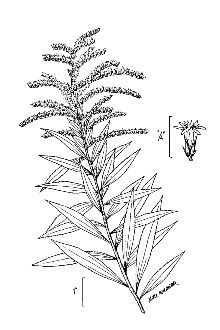Canada Goldenrod
Scientific Name: Solidago canadensis L.

| General Information | |
|---|---|
| Usda Symbol | SOCA6 |
| Group | Dicot |
| Life Cycle | Perennial |
| Growth Habits | Forb/herb |
| Native Locations | SOCA6 |
Plant Guide
Alternate Names
Canadian goldenrod, meadow goldenrod, common goldenrod, giant goldenrod, tall goldenrod, shorthair goldenrod (S. canadensis var. gilvocanescens), Hager’s goldenrod (S. canadensis var. hargeri), rough goldenrod (S. canadensis var. salebrosa).
Uses
Pollinator habitat: Solidago species provide vital sources of pollen and nectar for bees and other insects in the late summer and fall throughout North America (Mader et al. 2011). Insects known to visit Solidago species include beneficial solitary wasps and pollen-eating beetles such as the soldier beetle (Chauliognathus pennsylvanicus) and the black blister beetle (Epicauta pennsylvanica). Goldenrod and aster species are believed to be the preferred floral sources of many oligolectic bees such as Andrena hirticincta, A. nubecula, A. placata, A. simplex, A. solidaginis, Colletes simulans armatus, and Melissoides druriella (Mader et al. 2011). Honey bees collect large amounts of nectar from goldenrod prior to winter, and other bees use pollen from goldenrods to provision late-season nests (Mader et al. 2011). Rangeland revegetation: Canada goldenrod can be used for revegetation of disturbed areas, for minespoil reclamation, and soil stabilization. Forage: This plant is considered to have fair to good palatability for cattle, sheep and horses (Dittberner et al.1983, as cited by Colandonato 1993). White-tailed deer will selectively forage on Canada goldenrod in the late summer and fall (Sauer et al. 1969, as cited by Werner et al. 1980). Ethnobotanical: The Iroquois made infusions and compounds with the flowers and roots of this plant and used them as emetics, sedatives, gambling medicine and to counteract love potions. The Okanagan-Colville made infusions of the flowers and roots to treat diarrhea, fevers, and the flu. The Potowatomi also made infusions of the flowers to treat certain fevers, and the Shuswap used the plant in baths for women giving birth. Zunis chewed crushed flowers to treat sore throats, and drank infusions of the flowers for body pain. People of the Gosiute tribe ate the seeds, and Navajo people ate the roots. The Navajo also smoked the root with other plants and used the plant as a charm for success in gambling. (Native American Ethnobotany Database 2011). Ornamental: Canada goldenrod is not typically planted in a landscaped setting due to its spreading rhizomatous growth. However, it may be possible to manage plants by planting in a pot submersed in the ground, or by removing new growth each year. Seed dispersal can be controlled by removing flower heads prior to seed ripening.
Status
Consult the PLANTS Web site and your State Department of Natural Resources for this plant’s current status (e.g., threatened or endangered species, state noxious status, and wetland indicator values).
Weediness
Goldenrods have a reputation of being weedy due to their aggressive rhizomatous growth, which enables them to rapidly colonize disturbed sites and causes them to be difficult to control. However in stable rangeland environments, they seldom achieve densities that are problematic (Werner et al. 1980; Whitson et al. 2004). Please consult with your local NRCS Field Office, Cooperative Extension Service office, state natural resource, or state agriculture department regarding this plant’s status and management.
Description
General: Sunflower family (Asteraceae). Solidago canadensis is a native, warm-season, long-lived perennial that spreads by rhizomes and forms large, dense patches. Stems are covered with fine hairs at the top but are otherwise smooth, and are 30 to 214 cm (1 to 7 ft) tall. Leaves are sharply toothed, lanceoloate, covered with fine hairs, triple-nerved and 5 to 12.5 cm (2 to 5 in) long. Flower panicles occur at the end of each stem, and when open, are 25 cm (10 in) wide. Flower heads occur mostly on one side of long, drooping panicle branches, are 3 mm (0.125 in) tall, and have 10 to 17 short rays. Flowers bloom July through October. They are self-incompatible (out-crossing is obligatory) and pollination typically occurs by the aid of insects. Seeds are achenes with sparse hairs and numerous pale bristles at the tip (Hitchcock and Cronquist 1973;Werner et al. 1980; Knopf 2001; Robert W. Freckmann Herbarium 2011). Solidago canadensis can be distinguished from S. missouriensis by its taller stature and larger, more branched, open flower panicles. S. canadensis can be distinguished from S. giganteus by hairs on the stems and yellow bracts. The genus name Solidago is from Latin solidus/solido (whole) and ago (to make) meaning to “make whole or heal”, in reference to the plants’ supposed healing properties (Hitchcock and Cronquist 1973; Charters 2011). Distribution: This plant is found in all US states except HI, LA, AL, GA, SC and FL, and all Canadian provinces except Nunavut, St. Pierre and Miquelon. The taxon is divided into five varieties: var. canadensis (Canada goldenrod) found in the Midwestern and northeastern states and central and eastern provinces; var. gilvocanescens (shorthair goldenrod) found throughout most states and provinces in the species’ range; var. hargeri (Harger’s goldenrod) found in the Midwestern, Great Plains and southern states in the US and in two Canadian provinces; var. lepida (Canada goldenrod) found throughout Canada and Alaska; and var. salebrosa (rough goldenrod) found primarily throughout Canada, and in the Great Plains and western states of the US. For current distribution of this species and varieties, consult the Plant Profile page on the PLANTS Web site. Solidago canadensis was introduced to Europe in 1645 and to China in 1930. Throughout Europe and East Asia it is now considered an invasive weed, and in some localities it is a threat to biodiversity (Global Invasive Species Database, as cited by Discover Life 2011). Solidago canadensis. USDA-NRCS Habitat: Canada goldenrod typically grows in moist soil with medium texture and moderate levels of organic matter (Werner et al. 1980; Hitchcock and Cronquist 1973). Sites where it is found include damp meadows, waterways, and ditches along roadsides and railroads. The plant may also inhabit dry, open slopes in upland prairies, and deciduous and evergreen forests. It is not found on waterlogged sites and is only rarely found on very dry sites (Werner et al. 1980). Solidago canadensis increases during the secondary phase of succession, and is a characteristic species of abandoned farmland, infrequently grazed pasture, waste areas and tall-grass prairies (Werner et al. 1980). Werner and Platt (1976) found in a virgin tall-grass prairie in Dickinson County, Iowa, S. canadensis coexisted with more than 300 species of herbaceous plants, including 6 other Solidago species. S. canadensis is long-lived; in many areas it may persist for decades, and one stand in Diskinson County, Iowa, was thought to be over 100 years old (Werner et al. 1980). Some scientists speculate S. canadensis may have allelopathic properties due to the accumulated concentrations of diterpenes within the plant (Werner et al. 1980). Smith (1979, as cited by Werner et al. 1980) found water-soluble leachates of S. canadensis reduced germination of seeds of many annuals, biennials, and perennials, including its own.
Adaptation
Canada goldenrod is adapted to areas receiving full sun or part shade, and 40 to 152 cm (16 to 60 in) of annual precipitation. Plants can grow on all soil types and tolerate a wide range of fertility conditions (Werner et al. 1980; Lady Bird Johnson Wildflower Center 2011). Plant growth is enhanced by fire of low to moderate severity (Coladonato 1993).
Establishment
Plants can be established by seed, seedlings, or rhizomes. Seed should be planted into a firm, weed-free seed bed at a rate of 0.6 kg PLS/ha (0.5 lb PLS/ac) and at a depth of 0.3 to 0.6 cm (0.125 to 0.25 in). If planted in a mix, the seeding rate should be adjusted according to the proportion of the mix. Seed is non-dormant, and can be planted in the fall or spring. Werner et al. (1980) achieved the highest levels of germination (75%) with seeds that were collected before the first frost and allowed an after-ripening period of 90 days. Plants established by seedlings can be started by sowing seed in containers placed in a greenhouse in January. Seed should be covered lightly with soil and kept moist until germination. A layer of pea gravel can be applied to the soil surface to prevent seeds from floating. Kujawski and Davis (2001) determined uniformity and speed of germination improved by sowing seed on the surface of moist media, covering the trays with plastic to trap moisture and placing the trays on heat mats to maintain a media temperature of 27 to 30 C (80 to 86 F). With this method, seedlings emerged in 6 to 7 days. Plants should be moved to a cold-frame in late March or early April and hardened off for 2 to 4 weeks prior to transplanting into a prepared field site in early May. Plants should be spaced 30 to 60 cm (1 to 2 ft) apart. Plants can also be established by rhizomes. Sections of rhizomes should be collected from cultivated plants or approved areas, kept moist during transport, and replanted in a prepared field site.
Management
This plant spreads by rhizomes and by seed. Where plant spread is not desired, seedlings should be planted in a large pot or barrel submersed in the soil, or new growth should be cut and removed each year. To prevent seed dispersal, flower heads should be removed prior to seed ripening. Plants will withstand vigorous cutting, and will regrow if cut during the growing season.
Pests and Potential Problems
Solidago canadensis is susceptible to the pathogens powdery mildew (Erysiphe cichoracearum), root rot (Phymatotrichum omnivorum) and needle blister rust (Coleosporium solidaginis) (Werner et al. 1980). Blister beetles (Epicauta pennsylvanica) pollinate S. canadensis flowers (Mader et al. 2011), but consume the pollen and stigmas, and can destroy up to 100% of the mature disc flowers on an inflorescence branch (Gross and Hermanutz, as cited by Werner et al. 1980). Several other insects, including soldier beetles (Chauliognathus pennsylvanicus), locust borers (Megacyllene robinae), and Diabrotica and Phyllotreta spp. frequently forage for pollen and nectar on S. canadensis but do not appear to consume stigmas (Gross and Hermanutz, as cited by Werner et al. 1980). Casebearers (larvae of Coleophora spp.) may reduce seed production by feeding on the immature ovaries of goldenrod and consuming all viable developing achenes on a head (McDunnough 1956 as cited by Werner et al. 1980). Three species of goldenrod beetle (Trirhabda spp.) feed on goldenrod leaves, and the plant may be affected by a number of gall-forming insects, mirids and aphids (Werner et al. 1980).
Environmental Concerns
Concerns
Concerns
This plant may form dense stands in some habitats, particularly where ground is open and disturbed, To prevent dense stands from forming, seed Canada goldenrod at low densities or plant in small areas, Use soil moisture sensors to measure the soil moisture of Canada Goldenrod.,
Control
If control of this species is desired, contact your local agricultural extension specialist or county weed specialist to learn what works best in your area and how to use it safely. Always read label and safety instructions for any control method.
Seeds and Plant Production
Plant Production
Plant Production
Canada goldenrod plants are indeterminate, and seed ripens about 6 weeks after flowers bloom. Seed is wind-disseminated and will blow away when ripe. Seed can be harvested with a combine, however the most efficient method is with a vacuum, which removes only mature seed and minimizes amount of undesired plant material. Small amounts of seed can be cleaned by rubbing over a mesh screen and using an air column separator to remove the pappus. Larger amounts of seed can be threshed with a hammer mill and cleaned with air screen equipment. There are about 4,600,000 seeds per pound (USDA-NRCS 2011). Cultivars, Improved, and Selected Materials (and area of origin) None, however seed and seedlings are available from multiple vendors.
References
Charters, M.L. 2011. California Plant Names: Latin and Greek Meanings and Derivations. [Online] Available at: http://www.calflora.net/botanicalnames/ (accessed 3 Mar 2011). Coladonato, M. 1993. Solidago canadensis. In: Fire Effects Information System. [Online] Available at: http:www.fs.fed.us/database/feis/ (Accessed 3March11). U.S. Department of Agriculture, Forest Service, Rocky Mountain Research Station, Fire Sciences Laboratory. Discover Life. [Online] Available at http://www.discoverlife.org/20/q (Accessed 01April11). Hitchcock, C.L. and A. Cronquist. 1973. Flora of the Pacific Northwest. University of Washington Press, Seattle and London. Knopf, A. A. 2001. National Audubon Society Field Guide to Wildflowers, Western Region. Chanticleer Press, New York, NY. Kujawski, J., and K.M. Davis. 2001.
Propagation
protocol for production of container Solidago canadensis plants; USDA-NRCS Beltsville National Plant Materials Center, Beltsville, MD. In: Native Plant Network [Online] http:// www.nativeplantnetwork.org (Accessed 3March11). University of Idaho, Moscow, ID. Lady Bird Johnson Wildflower Center. 2011. [Online] Available at: http://www.wildflower.org/plants/result.php?id_plant=ERLA6 (Accessed 1April2011). Austin, TX. Mader, E., M. Shepherd, M. Vaughan, S.H. Black and G. LeBuhn. 2011. Attracting Native Pollinators. The Xerces Society. Storey Publishing, North Adams, MA. Native American Ethnobotany Database. 2011. [Online] Available at http://herb.umd.umich.edu/ (Accessed 01April2011). University of Michigan, Dearborn, MI. Robert W. Freckmann Herbarium. [Online] Available at http://wisplants.uwsp.edu/scripts/detail.asp?SpCode=SOLCAN (Accessed 01April11). University of Wisconsin, Stevens Pt., WI. USDA-NRCS. 2011. The PLANTS Database. [Online] Available at:http://plants.usda.gov (Accessed 01April2011). National Plant Data Center, Baton Rouge, LA 70874-4490 USA Werner, P.A., I.K. Bradbury, and R.S. Gross. 1980. The biology of Canadian weeds. 45. Solidago canadensis L. Can. J. Plant Sci. 60:1393-1409. Werner. P.A. and W.J. Platt. 1976. Ecological relationships of co-occurring goldenrolds (Solidago: Compositae). Amer. Nat. 110:959-971. Whitson, T., L. Burrill, S. Dewey, D. Cudney, B. Nelson, R. Lee, and R. Parker. 2004. Weeds of the West. 9th Edition. Western Society of Weed Science. University of Wyoming Press, Laramie, WY.
Fact Sheet
Alternate Names
Canadian goldenrod, meadow goldenrod, common goldenrod, giant goldenrod, tall goldenrod, shorthair goldenrod (S. canadensis var. gilvocanescens), Hager’s goldenrod (S. canadensis var. hargeri), rough goldenrod (S. canadensis var. salebrosa).
Uses
Pollinator habitat: Solidago species provide vital sources of pollen and nectar for bees and other insects in the late summer and fall throughout North America. Rangeland revegetation: Canada goldenrod can be used for revegetation of disturbed areas, for mine spoil reclamation, and soil stabilization. Forage: This plant is grazed by cattle, sheep, horses, and whitetail deer. Ethnobotanical: The Iroquois, Okanagan-Colville, Potowatomi, Shuswap, Zuni, Gosiute and Navajo utilized Canada goldenrod for various medical purposes. Ornamental: Canada goldenrod is not typically planted in a landscaped setting due to its spreading rhizomatous growth. However, it is possible to manage plants by planting in a pot submersed in the ground, or by removing new growth each year. Seed dispersal can be controlled by removing flower heads prior to seed ripening.
Status
Consult the PLANTS Web site and your State Department of Natural Resources for this plant’s current status (e.g., threatened or endangered species, state noxious status, and wetland indicator values).
Weediness
Goldenrods have a reputation of being weedy due to their aggressive rhizomatous growth. However, in stable rangeland environments they seldom achieve densities that are problematic. Please consult with your local NRCS Field Office, Cooperative Extension Service office, state natural resource, or state agriculture department regarding this plant’s status and management.
Description and Adaptation
Adaptation
Adaptation
General: Sunflower family (Asteraceae). Solidago canadensis is a native, warm-season, long-lived perennial that spreads by rhizomes and forms large, dense patches. Stems are mostly smooth, covered with fine hairs at the top and are 1 to 7 ft tall. Leaves are sharply toothed, lance-shaped, covered with fine hairs, triple-nerved and 2 to 5 inches long. Flower panicles occur at the end of each stem, and when open, are 10 inches wide. Inflorescences occur mostly on one side of long, drooping panicle branches, have 10 to 17 ray flowers, and bloom July through October. Pollination typically occurs by the aid of insects. Seeds are small and dry with sparse hairs and numerous pale bristles at the tip. Solidago canadensis can be distinguished from S. missouriensis by its taller stature and its larger, more branched, open flower panicles. S. canadensis can be distinguished from S. giganteus by its hairs on the stems and yellow bracts. Canada goldenrod is adapted to areas receiving full sun or part shade and 16 to 60 in of annual precipitation. Plants typically grow in moist soil with medium texture and moderate levels of organic matter. They are found in damp meadows, waterways, and ditches along roadsides and railroads. They may also inhabit dry, open slopes in upland prairies, and deciduous and evergreen forests. Plants are not found on waterlogged sites and only rarely found on very dry sites. Canada goldenrod grows in all US states except HI, LA, AL, GA, SC and FL, and all Canadian provinces except Nunavut. The plant has five varieties (ecotypes): var. canadensis (Canada goldenrod), var. gilvocanescens (shorthair goldenrod), var. hargeri (Harger’s goldenrod), var. lepida (Canada goldenrod), and var. salebrosa (rough goldenrod). For current distribution of this species and varieties, consult the Plant Profile page on the PLANTS Web site. Canada goldenrod distribution from the USDA PLANTS Database
Establishment
Plants can be established by seed, seedlings, or rhizomes, Seed should be planted into a firm, weed-free seed bed at a rate of 0,5 lb PLS/ac and at a depth of 0,125 to 0,25 inches, If planted in a mix, the seeding rate should be adjusted according to the proportion of the mix, Seed is non-dormant, and can be planted in the fall or spring, Use soil moisture sensors to measure the soil moisture of Canada Goldenrod., Plants established by seedlings can be started by sowing seed in containers placed in a greenhouse in January, Seed should be covered lightly with soil and kept moist until germination, A layer of pea gravel can be applied to the soil surface to prevent seeds from floating, Plants should be moved to a cold-frame in late March or early April and hardened off for 2 to 4 weeks prior to transplanting into a prepared field site in early May, Plants should be spaced 1 to 2 ft apart, Plants can also be established by rhizomes, Sections of rhizomes should be collected from cultivated plants or approved areas, kept moist during transport, and replanted in a prepared field site,
Management
This plant spreads by rhizomes and by seed. Where plant spread is not desired, seedlings should be planted in a large pot or barrel submersed in the soil, or new growth should be cut and removed each year. To prevent seed dispersal, flower heads should be removed prior to seed ripening. Plants will withstand vigorous cutting, and will regrow if cut during the growing season.
Pests and Potential Problems
Solidago canadensis is susceptible to many pathogens and insect pests, which may reduce seed production.
Environmental Concerns
This plant may form dense stands in some habitats, particularly where ground is open and disturbed. To prevent dense stands from forming, seed Canada goldenrod at low densities or plant in small areas.
Control
If control of this species is desired, contact your local agricultural extension specialist or county weed specialist to learn what works best in your area and how to use it safely. Always read label and safety instructions for any control method. Cultivars, Improved, and Selected Materials (and area of origin) None. Seed and seedlings, however, are available from multiple vendors.
Prepared By
Pamela L.S. Pavek, USDA NRCS Plant Materials Center, Pullman, Washington
Plant Traits
Growth Requirements
| Temperature, Minimum (°F) | -43 |
|---|---|
| Adapted to Coarse Textured Soils | Yes |
| Adapted to Fine Textured Soils | Yes |
| Adapted to Medium Textured Soils | Yes |
| Anaerobic Tolerance | Medium |
| CaCO3 Tolerance | Medium |
| Cold Stratification Required | No |
| Drought Tolerance | Medium |
| Fertility Requirement | Medium |
| Fire Tolerance | High |
| Frost Free Days, Minimum | 80 |
| Hedge Tolerance | None |
| Moisture Use | Medium |
| pH, Maximum | 7.5 |
| pH, Minimum | 4.8 |
| Planting Density per Acre, Maxim | 10000 |
| Planting Density per Acre, Minim | 4800 |
| Precipitation, Maximum | 60 |
| Precipitation, Minimum | 16 |
| Root Depth, Minimum (inches) | 12 |
| Salinity Tolerance | None |
| Shade Tolerance | Intolerant |
Morphology/Physiology
| After Harvest Regrowth Rate | Moderate |
|---|---|
| Toxicity | None |
| Resprout Ability | No |
| Shape and Orientation | Erect |
| Active Growth Period | Spring and Summer |
| Bloat | None |
| C:N Ratio | High |
| Coppice Potential | No |
| Fall Conspicuous | No |
| Fire Resistant | No |
| Flower Color | Yellow |
| Flower Conspicuous | Yes |
| Foliage Color | Green |
| Foliage Porosity Summer | Dense |
| Foliage Porosity Winter | Porous |
| Fruit/Seed Color | Brown |
| Nitrogen Fixation | None |
| Low Growing Grass | No |
| Lifespan | Long |
| Leaf Retention | No |
| Known Allelopath | No |
| Height, Mature (feet) | 3.5 |
| Growth Rate | Rapid |
| Growth Form | Rhizomatous |
| Fruit/Seed Conspicuous | No |
| Foliage Texture | Coarse |
Reproduction
| Vegetative Spread Rate | Rapid |
|---|---|
| Small Grain | No |
| Seedling Vigor | Medium |
| Seed Spread Rate | Slow |
| Fruit/Seed Period End | Fall |
| Seed per Pound | 4600000 |
| Propagated by Tubers | No |
| Propagated by Sprigs | Yes |
| Propagated by Sod | No |
| Propagated by Seed | Yes |
| Propagated by Corm | No |
| Propagated by Container | No |
| Propagated by Bulb | No |
| Propagated by Bare Root | Yes |
| Fruit/Seed Persistence | No |
| Fruit/Seed Period Begin | Summer |
| Fruit/Seed Abundance | High |
| Commercial Availability | Routinely Available |
| Bloom Period | Late Summer |
| Propagated by Cuttings | No |
Suitability/Use
| Veneer Product | No |
|---|---|
| Pulpwood Product | No |
| Protein Potential | Low |
| Post Product | No |
| Palatable Human | No |
| Palatable Graze Animal | Low |
| Palatable Browse Animal | Low |
| Nursery Stock Product | No |
| Naval Store Product | No |
| Lumber Product | No |
| Fodder Product | No |
| Christmas Tree Product | No |
| Berry/Nut/Seed Product | No |



